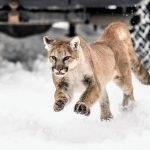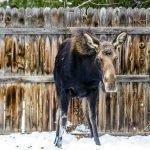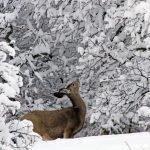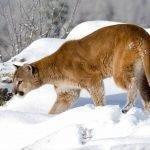Wildlife News Release
It’s been a wild winter along the Wasatch Front. In a single weekend, a mountain goat wandered into Cottonwood Heights, three cougars—one of which peered through a window—visited a home at the mouth of Mill Creek Canyon, and Division of Wildlife Resources (DWR) biologists and officers tranquilized and moved a cow moose and its calf from Bountiful.
What’s going on this year? And what should you do if wildlife shows up in your backyard? Darren DeBloois, the DWR biologist who oversees the management of cougars and bears in Utah, provides some answers.
Increased snowfall
After years of dry winters, the mountains along the heavily populated Wasatch Front have finally received some snow. As snow piles in the high country, deer, moose and other wildlife are moving to lower elevations, looking for food. Cougars, which prey mostly on deer, are following the deer into the valleys.
“It seems like something unusual is happening,” DeBloois says, “but given the conditions this year, it’s predictable. The mountains have finally received a decent amount of snow. That’s pushing the animals to lower elevations, where the snow isn’t as deep and food is easier to find.”
DeBloois says three additional factors—healthy wildlife populations, an increasing human population and more people with cameras on their houses—come into play too.
“Wild animals along the Wasatch Front are doing well,” he says. “Healthy populations of cougars, deer and moose are scattered along the foothills.”
DeBloois says historically, Utah’s lower-elevation areas—places with less snow and more woody vegetation—served as winter habitat for wildlife. “These areas still provide winter habitat for the animals,” he says, “but many of them are also filled with people and their homes. And more and more houses are now equipped with security cameras. The photos and videos these cameras capture can make it look like the number of animals in urban areas is increasing. In reality, many of the animals have been there all along. You just weren’t aware they were there.”
What to do
If you see wildlife in your backyard or in your town this winter or spring, what should you do? DeBloois provides the following tips:
Tip 1 – Keep your distance
Keep a good distance between you and the animal. Keeping your distance is the best way to stay safe and not cause the animal undue stress.
“Bad things can happen when people get too close to wildlife,” DeBloois says. “Closing the gap between you and an animal can cause the animal to feel threatened. If it feels threatened, it will sometimes attack to protect itself.”
DeBloois says it’s important to keep your distance from all wildlife, especially moose. “Moose often appear to be docile animals,” he says, “and they usually are, right up until the moment they feel threatened. Then, they can get aggressive. Moose are strong and fast. A moose can easily run you down.”
This is true for pets too. Dogs walking off leash have been known to provoke moose attacks that can escalate to attacks on people as they try to rescue their pets.
More often, the wild animal will flee, and that can be bad for animals like moose and deer, especially in late winter and early spring.
“It’s harder for some wildlife to find food in the winter,” DeBloois says. “And the food that is available might have limited nutritional value, or it could contain toxic compounds that limit the amount an animal can eat. That means the animals have to live off their fat reserves.”
By the end of the winter—even a normal winter—DeBloois says an animal’s reserves are nearly gone. “This is especially true for young animals that are using most of their energy to grow,” he says. “They have very little fat stored, even at the beginning of winter. If you scare an animal, like a moose or a deer, and cause it to run away from you, you’ve caused it to use up some of the essential fat reserves and energy it needs to survive.”
Tip 2 – Visit wildawareutah.org
In addition to keeping your distance, there are several things you can do to stay safe and not cause animals undue stress. For tips, visit www.wildawareutah.org/utah-wildlife-information.
Tip 3 – Only call if you feel threatened
The DWR receives many calls in the winter from people who have spotted wildlife in their backyards or somewhere in their town. Unless you feel the animal poses a threat to you or to others, there’s probably no reason to call. “Give the animal plenty of space,” DeBloois says, “and enjoy watching it. Having wildlife so close to us is one of the great things about living in Utah.”
- In the winter, moose can end up anywhere, including your back yard. DWR biologists shot this moose with a tranquilizer dart. It’ll be asleep soon.





